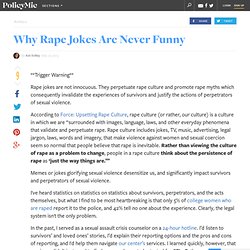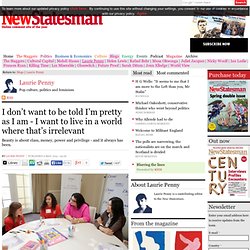

Patricia Lockwood, "Rape Joke" The rape joke is that you were 19 years old.

The rape joke is that he was your boyfriend. The rape joke it wore a goatee. A goatee. Imagine the rape joke looking in the mirror, perfectly reflecting back itself, and grooming itself to look more like a rape joke. “Ahhhh,” it thinks. No offense. The rape joke is that he was seven years older. Then suddenly you were older, but not very old at all. The rape joke is that you had been drinking wine coolers. The rape joke is he was a bouncer, and kept people out for a living. Not you! FYGIRLCRUSH. It takes more than two. My life with Androgen Insensitivity Syndrome Meet Christy North, who was born with Androgen Insensitivity Syndrome. 19, 2013 Call to end intersex genital operations Given a choice between male and female on official documents, Tony Briffa ticks both boxes but prefers to tick neither.

Briffa also prefers not be referred to as "he" or "she". Why Rape Jokes Are Never Funny. **Trigger Warning** Rape jokes are not innocuous.

They perpetuate rape culture and promote rape myths which consequently invalidate the experiences of survivors and justify the actions of perpetrators of sexual violence. According to Force: Upsetting Rape Culture, rape culture (or rather, our culture) is a culture in which we are “surrounded with images, language, laws, and other everyday phenomena that validate and perpetuate rape. Rape culture includes jokes, TV, music, advertising, legal jargon, laws, words and imagery, that make violence against women and sexual coercion seem so normal that people believe that rape is inevitable. Rather than viewing the culture of rape as a problem to change, people in a rape culture think about the persistence of rape as ‘just the way things are.’” Memes or jokes glorifying sexual violence desensitize us, and significantly impact survivors and perpetrators of sexual violence. GUILT. Why are men still proposing? We didn’t have much of an audience.

There was a couple just out of earshot reverently staring at the horizon, and a lone crow hovering in place a couple of feet in front of us, its glossy black body effortlessly buoyed by the lift of the ocean wind. ”Hey, you,” I told the bird, nonchalantly. “We just got engaged.” Christopher and I had hiked four miles through the mossy Point Reyes forest to a dramatic cliff overlooking the ocean. We sat in the dirt, which was pockmarked with mouse holes and accented with ice plant in electric-pink bloom. Turquoise waves churned below and a seagull took stomach-turning dives as we read each other letters we had written moments before alongside a shady creek. This was two weeks ago. When we returned home to the real world with our news, we were time and again asked to tell the story. I had to wonder whether these nontraditional sentiments suggested that change was afoot.
The truth, though, is that the male proposal is showing no signs of disappearing. I don’t want to be told I’m pretty as I am - I want to live in a world where that’s irrelevant. Body image is big business.

This spring, the Brazilian modelling agency Star Models has launched a graphic campaign with the intention of showing young women how horrific acute anorexia is. It shows models photoshopped to the proportions of fashion sketches – spindly legs, twig-like arms, wobbling lollipop heads. Given the high-profile deaths of two South American models from anorexia – one of whom, Luisel Ramos, dropped dead of heart failure at a catwalk show – one might interpret this as a way for the agency to detoxify its brand while drumming up a little publicity. But that would be too cynical; the global fashion industry really cares about young women’s health now. That’s why model agencies were recently discovered recruiting outside Swedish eating disorder clinics. Elsewhere, a new campaign video by Dove uses facial composite drawing to demonstrate how women underestimate their own looks.
Laurie Penny is the contributing editor of the New Statesman. From Ada Lovelace to Marissa Mayer: The Rise of Women in Tech [INFOGRAPHIC] Did you know that Ada Lovelace, a computer scientist from England, is considered to be the first computer programmer?
![From Ada Lovelace to Marissa Mayer: The Rise of Women in Tech [INFOGRAPHIC]](http://cdn.pearltrees.com/s/pic/th/lovelace-marissa-infographic-41795786)
With her code-like language, she created a model for Charles Babbage's analytical engine in the mid-1800s. Nearly two centuries later, there are some very impressive women working in technology, such as Yahoo CEO Marissa Mayer and Facebook COO Sheryl Sandberg. However, women still only make up just 25% of the workforce in STEM — that is, science, technology, engineering and mathematics — careers. This infographic takes a look at some of the brilliant ladies whose contributions to the STEM fields are an inspiration to all women — and men. SEE ALSO: STEM Careers: The Need to Get More Women Involved From the Start Take a look at this Hall of Fame for women in tech, science, engineering and math, created by Institute of Electrical and Electronics Engineers; then, let us know how you think we can encourage more women and girls to enter STEM careers in the comments section.